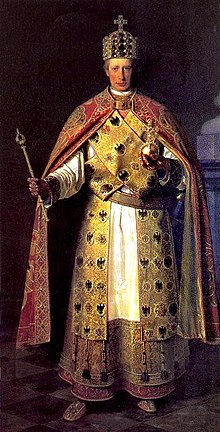Official costume

An official costume (or official clothing ) is the work clothing of a prominent group of public officials ; It represents the embodiment of a public office or a position in a profession. In Austria the term official dress is common. The difference to uniforms is that those wearing official costumes do not perform any executive or technical tasks and the cut of the clothing is not uniform , but rather festive and representative.
Representatives of religious communities
Christianity
When administering the sacraments, priests wear regalia (see liturgical robe ). Evangelical pastors (southern German name) or pastors (northern German name) wear gowns (but these are not liturgical garments in the true sense), each with headgear, if necessary. Lutheran pastors in the Independent Evangelical Lutheran Church wear regalia or black gowns, depending on the parish resolution. Monks wear a habit , possibly a waist cord and hood, abbots wear a necklace with a pectoral cross. Religious sisters wear a sister's costume or habit with a hood. Acolytes wear an altar boy dress.
Outside of church services, Roman Catholic clergymen can wear a Ferraiolo in the color to which they are entitled (priests black, bishops purple, cardinals purple) on special occasions .
Buddhism
Monks wear a monk's robe in a throw-over manner without a cord and headgear.
Public administration representative
General Administration
Local government : Registrars occasionally when performing the (secular) wedding ceremony
Judiciary
In Germany, the wearing judge , prosecutors , lawyers and secretary during the negotiations robes (in Baden-Württemberg due to § 21 AGGVG). The design of the official costume is regulated by implementing ordinances. In a broader sense, the robe of the private persons participating in a court hearing (e.g. lawyers) is also an official attire, since they act as organs of the administration of justice . Lawyers can be turned away for the respective trial date, provided they are not wearing a robe. They also expose themselves to professional sanctions. According to § 20 sentence 2 BORA, lawyers in civil proceedings before the district court are no longer obliged to wear a robe. Unauthorized wearing of official clothing in public is an offense in Germany ( Section 132a (1) No. 4 StGB - misuse of titles, job titles and badges ).
In Austria , too , judges and public prosecutors wear official clothes that consist of a gown and headgear ( beret ). The use of an official dress by lawyers is permitted, apart from jury cases and proceedings before the Supreme Court, but it has become completely unusual. In civil hearings, especially before district courts, wearing by the judge is also increasingly out of practice.
In Switzerland , no official costume is worn in court. In military courts , on the other hand, it is usually mandatory to wear a uniform .
In the United Kingdom , it is still common for wigs with curls to be worn with robes.
In Russia , prosecutors also wear uniforms .
Colleges
High-level staff at some universities such as B. Deans and rectors wear gowns on festive occasions. Until 1968, professors also wore gowns, but only on appropriate occasions. As a peculiarity in the German higher education system, the university teaching staff of the Bergakademie Freiberg wore the miner's uniform on special occasions until the 1970s . At the Clausthal University of Technology, which emerged from a mining academy, and at the Montan University Leoben (Austria), this is still the case on many occasions.
However, it is no longer common for many universities to wear a gown these days. Only almost all rectors wear a chain of office .
Diplomatic service
In many countries around the world, it is still customary today for their representatives to wear certain, prescribed clothing on official occasions (e.g. the uniform of the Russian ambassador).
Individual evidence
- ↑ For example in the Free State of Bavaria: Official costume in the ordinary jurisdiction, announcement of September 21, 2016 ( JMBl. P. 118 )
- ↑ see e.g. BVerfGE 28, 21-36; OLG Munich NJW 2006, 3079-3080; Higher Regional Court Karlsruhe NJW 1977, 309
- ↑ Professional code of conduct for lawyers (PDF; 48.5 kB), as amended on September 1, 2014.
